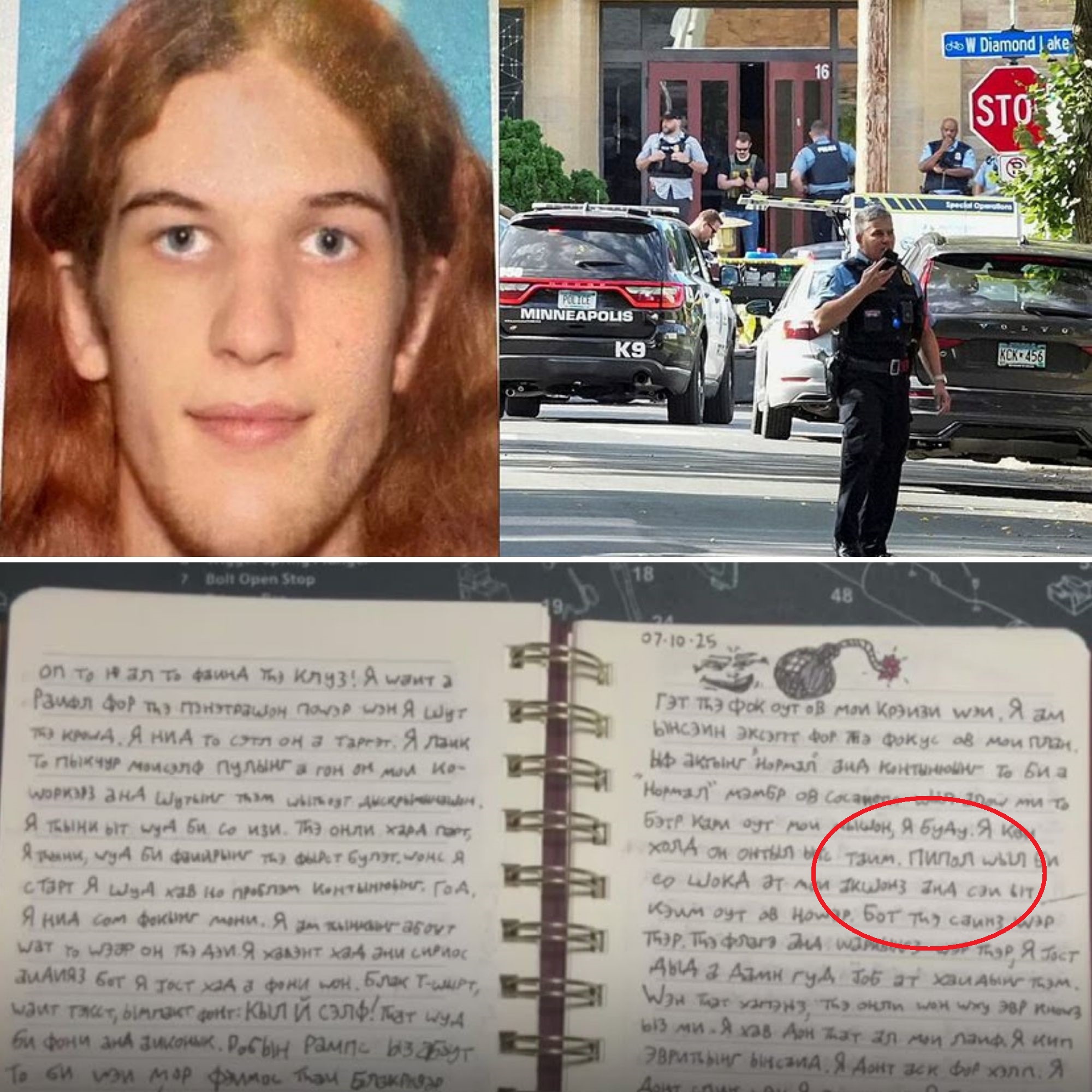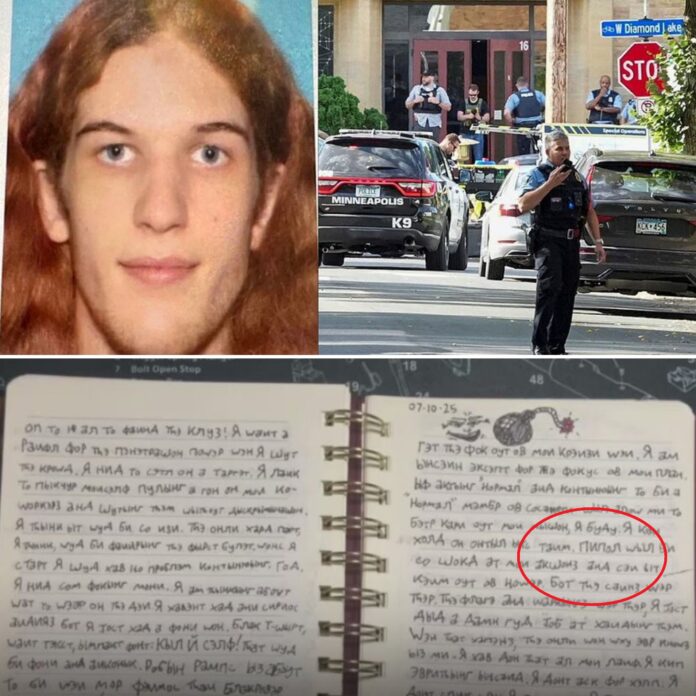A chilling plan revealed in the Minneapolis tragedy…
The world is reeling after a shooter’s detailed documents surfaced, exposing the horrifying blueprint behind the attack at Annunciation Catholic School. What could drive someone to target innocent children in such a calculated way? The clues in these shocking writings are haunting—and the truth is even more unsettling. Click to dive into the details of this heartbreaking story.
👉 Read more here

On August 27, 2025, a devastating act of violence rocked Minneapolis, Minnesota, when 23-year-old Robin Westman opened fire during a morning Mass at Annunciation Catholic School, killing two children, aged 8 and 10, and injuring 17 others, including 14 children and three elderly parishioners. The shooter, who died by a self-inflicted gunshot wound, left behind a series of documents and videos that outlined a meticulously planned attack, sending shockwaves through the local community and the world. These materials, described by authorities as deeply disturbing, provide a chilling glimpse into the mind of the perpetrator and raise critical questions about motive, mental health, and the societal factors that enable such tragedies.
The Attack at Annunciation Catholic School
The tragedy unfolded just before 8:30 a.m. at Annunciation Catholic Church, adjacent to the school, where students from preschool through eighth grade were gathered to celebrate the start of the academic year. The shooter, dressed in black and armed with a legally purchased rifle, shotgun, and pistol, approached the church’s exterior and began firing through its stained-glass windows, targeting children and worshippers seated in the pews. In a calculated move, the suspect barricaded two church exits with wooden planks, trapping victims inside and amplifying the chaos.
The two children killed, an 8-year-old and a 10-year-old, were pronounced dead at the scene. Among the injured, 14 children aged 6 to 15 and three adults in their 80s were rushed to hospitals, with two children initially in critical condition but expected to survive. Minneapolis Police Chief Brian O’Hara called the attack an act of “incomprehensible cruelty,” noting the bravery of school staff who shielded students and first responders who risked their lives to save them. Stories of heroism emerged, including that of 10-year-old Weston Halsne, who recounted how his friend Victor took a bullet to protect him.
The shooter, identified as Robin Westman, had personal ties to the school. Westman attended Annunciation for at least one year and their mother, Mary Grace Westman, worked in the school’s business office until her retirement in 2021. These connections have fueled speculation about the motive, though authorities have yet to confirm a definitive reason. The FBI, under Director Kash Patel, is investigating the incident as an act of domestic terrorism and a hate crime targeting Catholics, adding a layer of complexity to the case.
The Disturbing Documents and Videos
At the heart of the investigation are the documents and videos Westman left behind, which authorities say outline a carefully planned attack. A manifesto, timed for release on YouTube during the shooting, included handwritten notes and videos that revealed Westman’s obsession with violence and mass shootings. These materials, now removed from the platform with FBI assistance, contained a mix of English and Russian text, including references to notorious mass shooters like Adam Lanza and Robert Bowers, as well as antisemitic slurs, calls to “kill Donald Trump,” and phrases like “for the children” scrawled on ammunition magazines.
One video showed Westman flipping through a notebook filled with diagrams of the church’s interior, drawn from memory, and a detailed plan to target the school during its first week. An entry dated May 23, 2025, allegedly described Westman’s fixation on school shootings, dating back to seventh grade, and conversations with friends about such acts. Another entry from August 20 detailed a visit to the church during teacher training week, noting that staff were likely undergoing active shooter drills—ironically, unaware of the real threat looming. Westman also wrote about using a paycheck from early August to purchase an AR-15 rifle and high-capacity magazines, indicating months of preparation.
The videos were particularly unsettling, with Westman giggling and muttering phrases like “I wanna kill myself” while showcasing an arsenal of weapons. Some firearms bore inscriptions referencing the Holocaust, antigay slurs, and other mass shooters, suggesting a blend of personal despair and ideological influences. A piece of wood marked “no escape” was used to barricade a church exit, a detail that underscored the premeditated nature of the attack. Minneapolis Police Chief O’Hara noted that the materials are under active review, as investigators work to piece together the shooter’s motives and potential radicalization.
A Community in Shock
The Annunciation Catholic School shooting has left Minneapolis grieving and searching for answers. Archbishop Bernard Hebda received a telegram from Pope Leo XIV, who offered condolences and prayers for the victims and their families. Principal Matt DeBoer, speaking at a press conference, referenced the school’s theme of hope from Jeremiah 29 but acknowledged the profound despair caused by the tragedy. “Children were ducked down. Adults were protecting children. Older children were protecting younger ones,” he said, highlighting the courage displayed in the face of horror.
Parents shared harrowing accounts of the chaos. Vincent Francoual, whose 11-year-old daughter Chloe survived by hiding in a room, described her trauma and guilt for leaving a classmate behind as she fled. Another parent, Renee Lego, recounted her son mistaking the gunfire for fireworks before witnessing people fall. Community members gathered at a vigil in Richfield, Minnesota, where Governor Tim Walz and Senator Amy Klobuchar joined hundreds in mourning. The school, a cornerstone of the community for generations, has become a symbol of both loss and resilience.
Unraveling the Motive
The documents and videos suggest a complex mix of personal struggles and external influences. Westman’s writings revealed deep depression and self-hatred, with one entry stating, “I am not well. I am haunted by these thoughts that do not go away.” The shooter’s legal name change in 2020, from Robert to Robin, and their identification as female have sparked debate, particularly after Mayor Jacob Frey urged the public to avoid “villainizing” the transgender community. Frey emphasized unity, stating, “We must focus on the victims and not let hate divide us further.”
The references to mass shooters, antisemitic rhetoric, and political figures like Donald Trump point to possible radicalization through online subcultures. The videos’ mention of gun rights activist Brandon Herrera, who condemned the shooter, and a German band linked to the Columbine shooters, suggest a fascination with extremist ideologies. However, Chief O’Hara cautioned that no motive has been confirmed, and the FBI is exploring all possibilities, including mental health issues and ideological motivations.
The legally purchased firearms have reignited calls for stricter gun control. Westman, with no prior criminal history, acquired the weapons shortly before the attack, raising questions about gaps in the system. Governor Walz, former presidents, and local leaders have expressed solidarity, but the tragedy has intensified debates about how to prevent such acts in a country plagued by gun violence.
The Path to Healing and Prevention
As Minneapolis mourns, the focus is shifting to recovery and prevention. Mental health resources, including the 988 Suicide and Crisis Lifeline, are being promoted to support survivors and the community. The archdiocese is providing counseling, and interfaith leaders are working to foster healing. Schools across Minnesota are reviewing security protocols, with Annunciation’s active shooter drills credited for saving lives, though they couldn’t prevent the tragedy.
The documents left by Westman highlight the need to address mental health crises, online radicalization, and firearm access. The FBI’s classification of the attack as domestic terrorism underscores the growing threat of targeted violence against religious institutions. Experts are calling for increased monitoring of online platforms where extremist rhetoric thrives, as well as better support for individuals showing signs of distress or obsession with violence.
Conclusion
The Minneapolis Catholic school shooting is a stark reminder of the fragility of safety in places meant to be sanctuaries. The documents and videos left by Robin Westman reveal a deeply troubled individual whose actions have left a lasting scar on a community. As investigators continue to unravel the motives behind this calculated attack, the focus remains on honoring the two young victims, supporting the survivors, and preventing future tragedies. The world watches as Minneapolis grapples with grief, seeking hope and answers in the wake of an unthinkable act.
